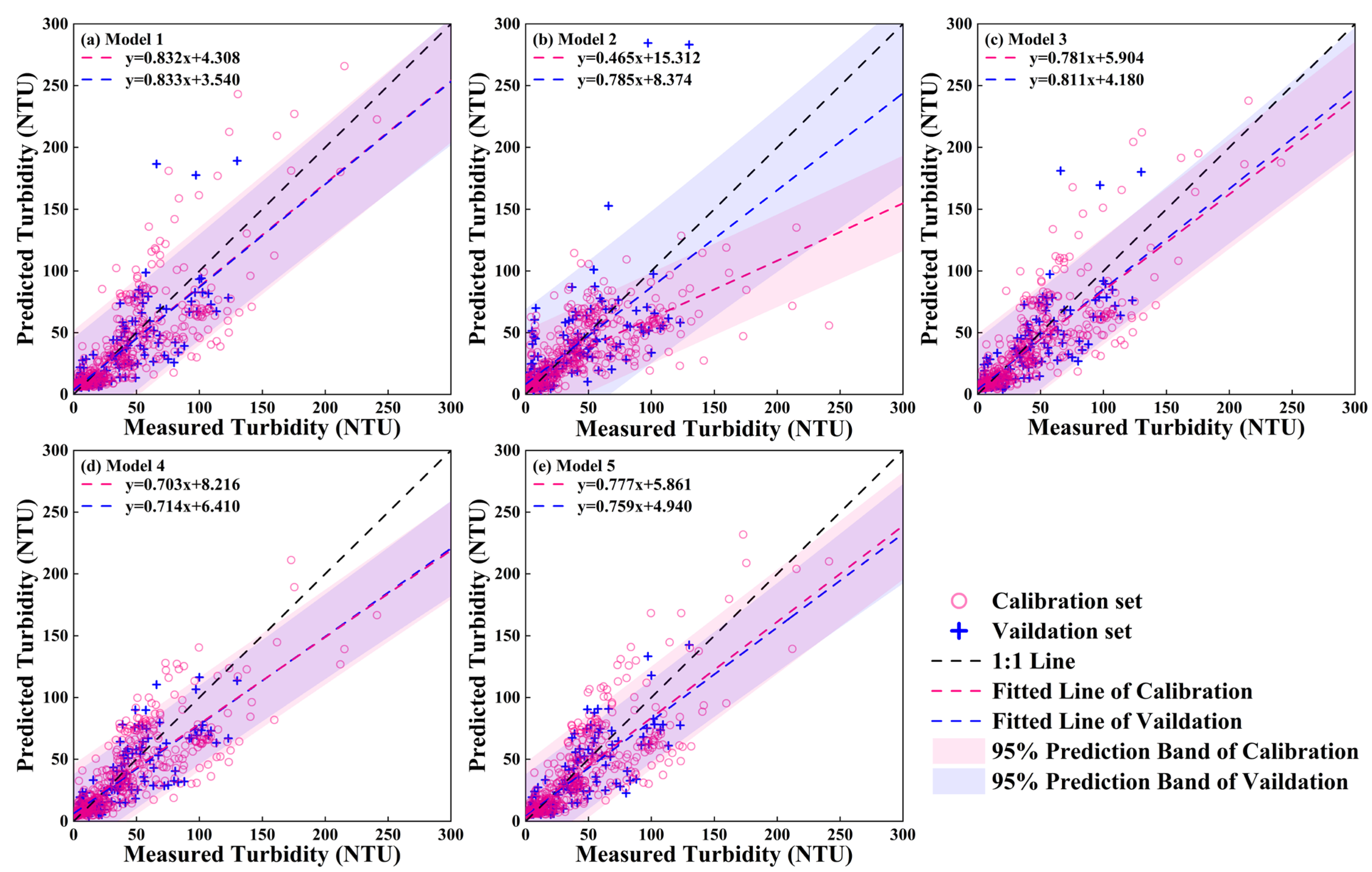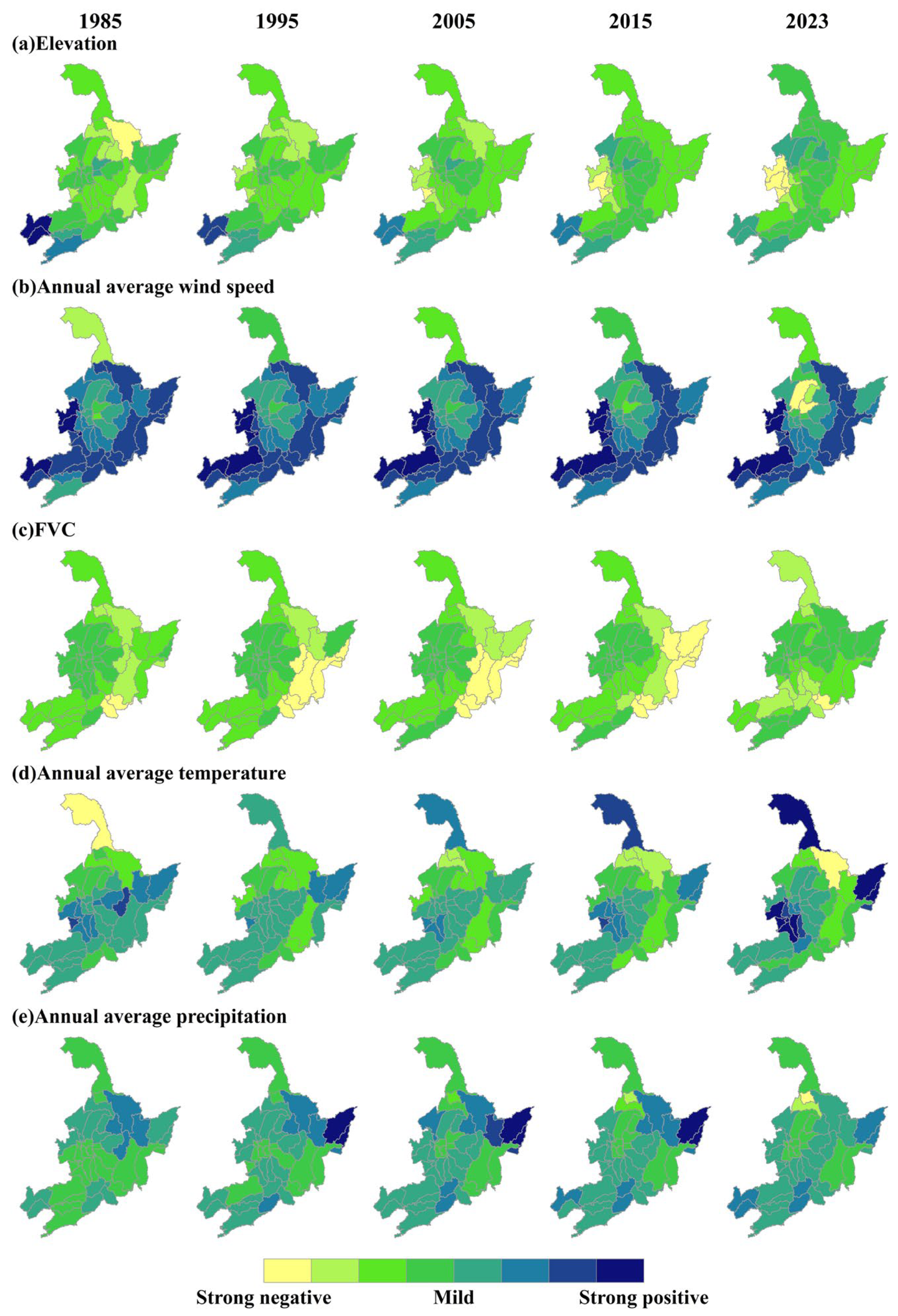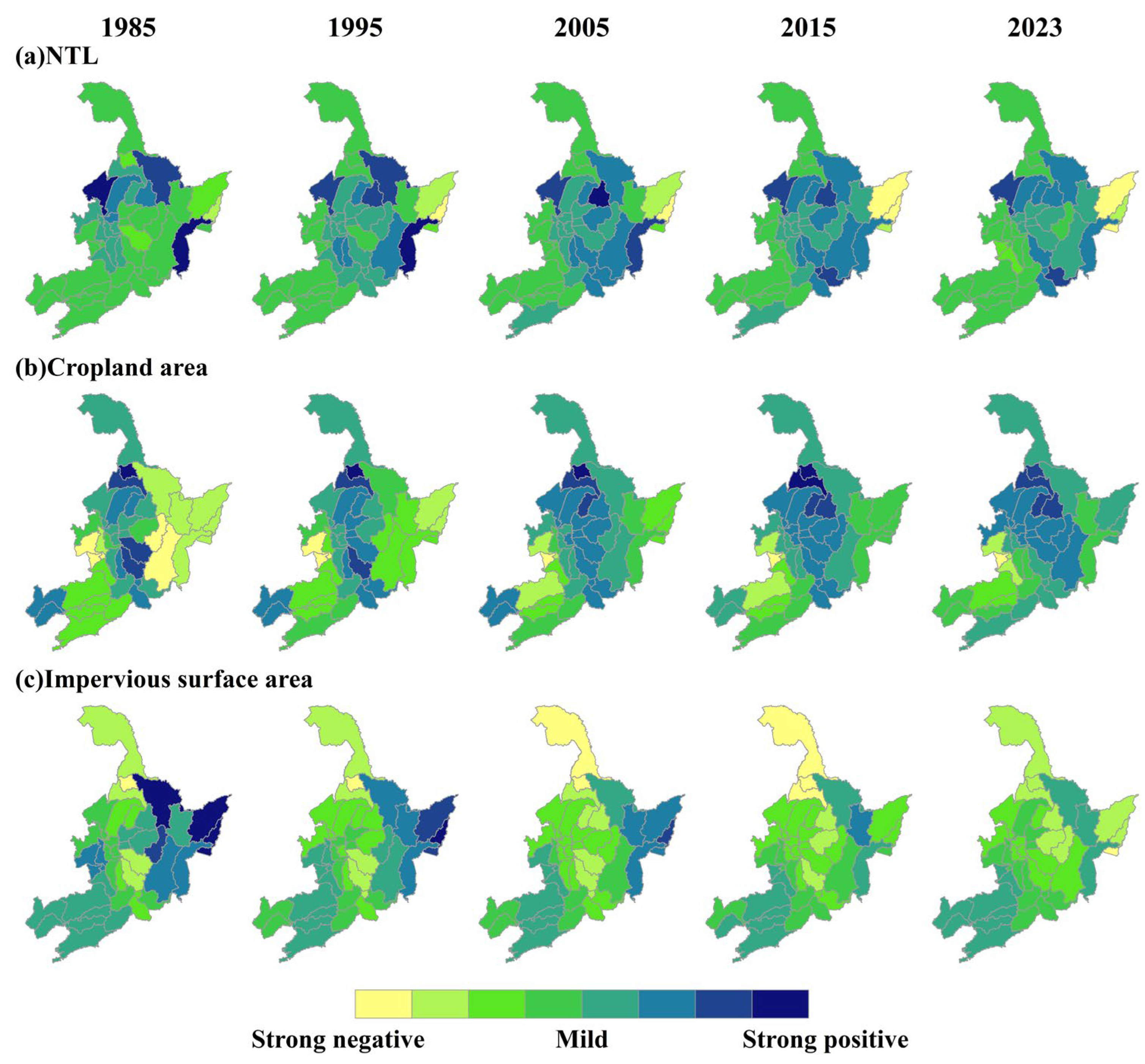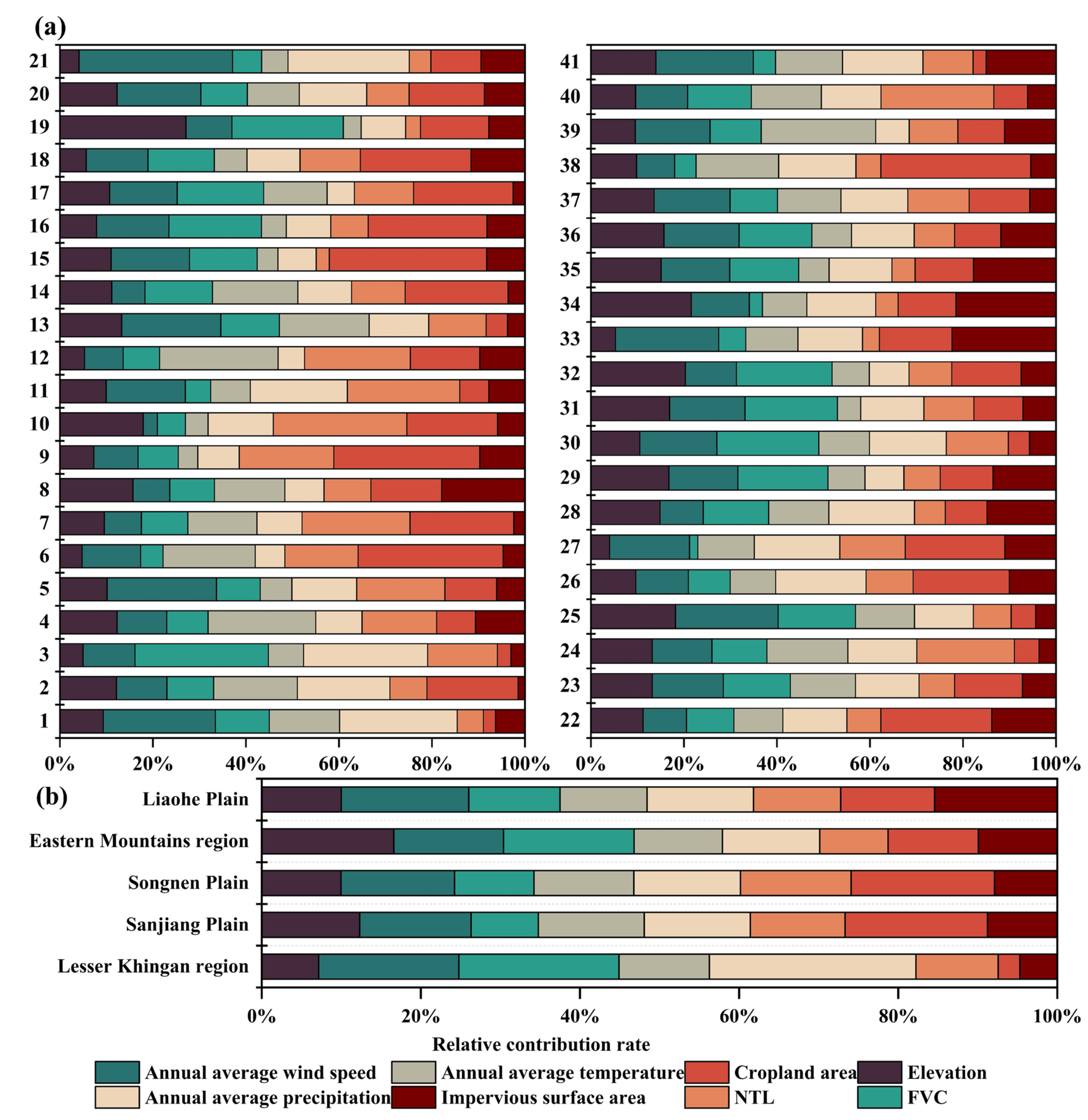Quantifying the Spatiotemporal Dynamics and Driving Factors of Lake Turbidity in Northeast China from 1985 to 2023
Highlights
- The long-term spatiotemporal dynamics and driving factors of water turbidity were quantified based on Landsat data across Northeast China from 1985 to 2023.
- A combination of GTWR, LMG, and statistical data analysis methods effectively revealed crucial spatiotemporal driving factors of turbidity variations at watershed scale.
- This study offers valuable insights into how influencing factors respond to turbidity changes and promotes aquatic ecosystem sustainability under human activities and climate change.
- This study provides a practical method to deepen understanding of environmental responses to water quality changes and offers crucial decision-making support for effective environmental protection.
Abstract
1. Introduction
2. Materials and Methods
2.1. Study Area
2.2. Datasets
2.2.1. Satellite Imagery and Geospatial Data Acquisition and Preprocessing
2.2.2. In Situ Data Collection and Laboratory Analysis
2.3. Methods
2.3.1. Turbidity Retrieval Models and Spatiotemporal Dynamics Method
2.3.2. Influencing Factors Analysis Method
3. Results
3.1. Measured Turbidity Statistical Analysis
3.2. Estimation Models for Water Turbidity
3.3. Spatiotemporal Patterns of Turbidity
3.4. Spatiotemporal Patterns of Turbidity Coefficient of Variation
3.5. Driving Factors for Turbidity
3.5.1. Hydrological Factors Based on Statistical Data Analysis
3.5.2. Spatiotemporal Influence of Environmental Factors Based on GTWR
3.5.3. Contribution Rates of the Driving Factors Based on the LMG Method
4. Discussion
4.1. Model Assessment and Turbidity Mapping
4.2. Influence of Driving Factors on Long-Term Turbidity Variations
4.3. Uncertainty Analysis and Future Perspectives
5. Conclusions
Author Contributions
Funding
Data Availability Statement
Acknowledgments
Conflicts of Interest
References
- Gleick, P.H. Global freshwater resources: Soft-path solutions for the 21st century. Science 2003, 302, 1524–1528. [Google Scholar] [CrossRef] [PubMed]
- Pekel, J.F.; Cottam, A.; Gorelick, N.; Belward, A.S. High-resolution mapping of global surface water and its long-term changes. Nature 2016, 540, 418–422. [Google Scholar] [CrossRef] [PubMed]
- Kuhn, C.; de Matos Valerio, A.; Ward, N.; Loken, L.; Sawakuchi, H.O.; Kampel, M.; Richey, J.; Stadler, P.; Crawford, J.; Striegl, R.; et al. Performance of Landsat-8 and Sentinel-2 surface reflectance products for river remote sensing retrievals of chlorophyll-a and turbidity. Remote Sens. Environ. 2019, 224, 104–118. [Google Scholar] [CrossRef]
- Deng, X.Y.; Song, C.Q.; Liu, K.; Ke, L.H.; Zhang, W.S.; Ma, R.H.; Zhu, J.Y.; Wu, Q.H. Remote sensing estimation of catchment-scale reservoir water impoundment in the upper yellow river and implications for river discharge alteration. J. Hydrol. 2020, 585, 124791. [Google Scholar] [CrossRef]
- Zhang, L.; Xin, Z.H.; Feng, L.; Hu, C.M.; Zhou, H.C.; Wang, Y.; Song, C.C.; Zhang, C. Turbidity dynamics of large lakes and reservoirs in northeastern China in response to natural factors and human activities. J. Clean. Prod. 2022, 368, 133148. [Google Scholar] [CrossRef]
- Zhang, K.; Li, L.J.; Bai, P.; Li, J.Y.; Liu, Y.M. Influence of climate variability and human activities on stream flow variation in the past 50 years in Taoer River, Northeast China. J. Geogr. Sci. 2017, 27, 481–496. [Google Scholar] [CrossRef]
- Xu, H.; Paerl, H.W.; Qin, B.; Zhu, G.; Hall, N.S.; Wu, Y. Determining critical nutrient thresholds needed to control harmful cyanobacterial blooms in eutrophic Lake Taihu, China. Environ. Sci. Technol. 2015, 49, 1051–1059. [Google Scholar] [CrossRef]
- Carey, C.C.; Ibelings, B.W.; Hoffmann, E.P.; Hamilton, D.P.; Brookes, J.D. Eco-physiological adaptations that favour freshwater cyanobacteria in a changing climate. Water Res. 2012, 46, 1394–1407. [Google Scholar] [CrossRef]
- Huisman, J.; Codd, G.A.; Paerl, H.W.; Ibelings, B.W.; Verspagen, J.M.; Visser, P.M. Cyanobacterial blooms. Nat. Rev. Microbiol. 2018, 16, 471–483. [Google Scholar] [CrossRef]
- Davies-Colley, R.J.; Smith, D.G. Turbidity suspeni)ed sediment, and water clarity: A review. J. Am. Water Resour. Assoc. 2001, 37, 1085–1101. [Google Scholar] [CrossRef]
- Ayana, E. Determinants of Declining Water Quality; World Bank Group: Washington, DC, USA, 2019. [Google Scholar]
- Gao, P.; Pasternack, G.B.; Bali, K.M.; Wallender, W.W. Estimating suspended sediment concentration using turbidity in an irrigation-dominated southeastern California watershed. J. Irrig. Drain. Eng. 2008, 134, 250–259. [Google Scholar] [CrossRef]
- McCarthy, M.J.; Muller-Karger, F.E.; Otis, D.B.; Méndez-Lázaro, P. Impacts of 40 years of land cover change on water quality in Tampa Bay, Florida. Cogent Geosci. 2018, 4, 1422956. [Google Scholar] [CrossRef]
- Dogliotti, A.I.; Ruddick, K.G.; Nechad, B.; Doxaran, D.; Knaeps, E. A single algorithm to retrieve turbidity from remotely-sensed data in all coastal and estuarine waters. Remote Sens. Environ. 2015, 156, 157–168. [Google Scholar] [CrossRef]
- Li, Y.; Li, S.J.; Song, K.S.; Liu, G.; Wen, Z.D.; Fang, C.; Shang, Y.X.; Lyu, L.L.; Zhang, L.L. Sentinel-3 OLCI observations of Chinese lake turbidity using machine learning algorithms. J. Hydrol. 2023, 622, 129668. [Google Scholar] [CrossRef]
- Sipelgas, L.; Raudsepp, U.; Kõuts, T. Operational monitoring of suspended matter distribution using MODIS images and numerical modelling. Adv. Space Res. 2006, 38, 2182–2188. [Google Scholar] [CrossRef]
- Duan, W.; Takara, K.; He, B.; Luo, P.; Nover, D.; Yamashiki, Y. Spatial and temporal trends in estimates of nutrient and suspended sediment loads in the Ishikari River, Japan, 1985 to 2010. Sci. Total Environ. 2013, 461–462, 499–508. [Google Scholar] [CrossRef]
- Caballero, I.; Navarro, G.; Ruiz, J. Multi-platform assessment of turbidity plumes during dredging operations in a major estuarine system. Int. J. Appl. Earth Obs. 2018, 68, 31–41. [Google Scholar] [CrossRef]
- Peterson, K.T.; Sagan, V.; Sloan, J.J. Deep learning-based water quality estimation and anomaly detection using Landsat-8/Sentinel-2 virtual constellation and cloud computing. GISci. Remote Sens. 2020, 57, 510–525. [Google Scholar] [CrossRef]
- Bustamante, J.; Pacios, F.; Diaz-Delgado, R.; Aragones, D. Predictive models of turbidity and water depth in the Doana marshes using Landsat TM and ETM+ images. J. Environ. Manag. 2009, 90, 2219–2225. [Google Scholar] [CrossRef]
- Jiang, X.Z.; Lu, B.; He, Y.H. Response of the turbidity maximum zone to fluctuations in sediment discharge from river to estuary in the Changjiang Estuary (China). Estuar. Coast. Shelf Sci. 2013, 131, 24–30. [Google Scholar] [CrossRef]
- Shen, X.; Feng, Q. Statistical model and estimation of inland riverine turbidity with Landsat 8 OLI images: A case study. Environ. Eng. Sci. 2018, 35, 132–140. [Google Scholar] [CrossRef]
- Erena, M.; Domínguez, J.A.; Aguado-Giménez, F.; Soria, J.; García-Galiano, S. Monitoring Coastal Lagoon Water Quality through Remote Sensing: The Mar Menor as a Case Study. Water 2019, 11, 1468. [Google Scholar] [CrossRef]
- Sebastiá-Frasquet, M.-T.; Aguilar-Maldonado, J.A.; Santamaría-Del-Ángel, E.; Estornell, J. Sentinel 2 Analysis of Turbidity Patterns in a Coastal Lagoon. Remote Sens. 2019, 11, 2926. [Google Scholar] [CrossRef]
- Doxaran, D.; Froidefond, J.M.; Castaing, P.; Babin, M. Dynamics of the turbidity maximum zone in a macrotidal estuary (the Gironde, France): Observations from field and MODIS satellite data. Estuar. Coast. Shelf Sci. 2009, 81, 321–332. [Google Scholar] [CrossRef]
- Petus, C.; Chust, G.; Gohin, F.; Doxaran, D.; Froidefond, J.M.; Sagarminaga, Y. Estimating turbidity and total suspended matter in the Adour River plume (South Bay of Biscay) using MODIS 250-m imagery. Cont. Shelf Res. 2010, 30, 379–392. [Google Scholar] [CrossRef]
- Urquhart, E.A.; Schaeffer, B.A. Envisat MERIS and Sentinel-3 OLCI satellite lake biophysical water quality flag dataset for the contiguous United States. Data Brief 2020, 28, 104826. [Google Scholar] [CrossRef]
- Wang, S.Q.; Mao, Y.; Zheng, L.F.; Qiu, Z.F.; Bilal, M.; Sun, D.Y. Remote sensing of water turbidity in the eastern China seas from geostationary ocean colour imager. Int. J. Remote Sens. 2020, 41, 4080–4101. [Google Scholar] [CrossRef]
- Wu, D.F.; Tang, T.; Odermatt, D.; Liu, W.F. Spatiotemporal variability in global lakes turbidity derived from satellite imageries. Environ. Res. Commun. 2025, 7, 035007. [Google Scholar] [CrossRef]
- Song, K.S.; Wang, Q.; Liu, G.; Jacinthe, P.A.; Li, S.J.; Tao, H.; Du, Y.X.; Wen, Z.D.; Wang, X.; Guo, W.W.; et al. A unified model for high resolution mapping of global lake (>1 ha) clarity using Landsat imagery data. Sci. Total Environ. 2022, 810, 151188. [Google Scholar] [CrossRef]
- Zhang, Y.Z.; Pulliainen, J.T.; Koponen, S.S.; Hallikainen, M.T. Water quality retrievals from combined Landsat TM data and ERS-2 SAR data in the Gulf of Finland. IEEE Trans. Geosci. Remote 2003, 41, 622–629. [Google Scholar] [CrossRef]
- Silveira Kupssinskü, L.; Thomassim Guimarães, T.; Menezes de Souza, E.; Zanotta, D.C.; Roberto Veronez, M.; Gonzaga, L., Jr.; Mauad, F.F. A Method for Chlorophyll-a and Suspended Solids Prediction through Remote Sensing and Machine Learning. Sensors 2020, 20, 2125. [Google Scholar] [CrossRef]
- Wang, Y.F.; Chen, J.; Cai, H.; Yu, Q.; Zhou, Z. Predicting water turbidity in a macro-tidal coastal bay using machine learning approaches. Estuar. Coast. Shelf Sci. 2021, 252, 107276. [Google Scholar] [CrossRef]
- Wan, S.; Yeh, M.L.; Ma, H.L.; Chou, T.Y. The Robust Study of Deep Learning Recursive Neural Network for Predicting of Turbidity of Water. Water 2022, 14, 761. [Google Scholar] [CrossRef]
- Kumar, L.; Afzal, M.S.; Ahmad, A. Prediction of water turbidity in a marine environment using machine learning: A case study of Hong Kong. Reg. Stud. Mar. Sci. 2022, 52, 102260. [Google Scholar] [CrossRef]
- Palmer, S.C.; Kutser, T.; Hunter, P.D. Remote sensing of inland waters: Challenges, progress and future directions. Remote Sens. Environ. 2015, 157, 1–8. [Google Scholar] [CrossRef]
- Wischmeier, W.H.; Smith, D.D. Predicting Rainfall Erosion Losses: A Guide to Conservation Planning; Department of Agriculture, Science and Education Administration: Washington, DC, USA, 1978. [Google Scholar]
- Yang, S.L.; Wang, J.; Cong, W.; Cai, Z.L.; Ouyang, F. Utilization of nitrite as a nitrogen source by Botryococcus braunii. Biotechnol. Lett. 2004, 26, 239–243. [Google Scholar] [CrossRef]
- Ouyang, T.P.; Zhu, Z.Y.; Kuang, Y.Q. Assessing impact of urbanization on river water quality in the Pearl River Delta Economic Zone, China. Environ. Monit. Assess. 2006, 120, 313–325. [Google Scholar] [CrossRef]
- Uriarte, M.; Yackulic, C.B.; Lim, Y.; Arce-Nazario, J.A. Influence of land use on water quality in a tropical landscape: A multi-scale analysis. Landscape Ecol. 2011, 26, 1151–1164. [Google Scholar] [CrossRef]
- Li, S.J.; Kutser, T.; Song, K.S.; Liu, G.; Li, Y. Lake Turbidity Mapping Using an OWTs-bp Based Framework and Sentinel-2 Imagery. Remote Sens. 2023, 15, 2489. [Google Scholar] [CrossRef]
- Wang, X.D.; Song, K.S.; Wen, Z.D.; Liu, G.; Shang, Y.X.; Fang, C.; Lyu, L.L.; Wang, Q. Quantifying turbidity variation for lakes in Daqing of Northeast China using Landsat images from 1984 to 2018. IEEE J. Sel. Top. Appl. Earth Obs. Remote Sens. 2021, 14, 8884–8897. [Google Scholar] [CrossRef]
- Zhou, Q.; Wang, J.R.; Tian, L.Q.; Feng, L.; Li, J.; Xing, Q.G. Remotely sensed water turbidity dynamics and its potential driving factors in Wuhan, an urbanizing city of China. J. Hydrol. 2021, 593, 125893. [Google Scholar] [CrossRef]
- Chu, H.-J.; Kong, S.-J.; Chang, C.-H. Spatio-temporal water quality mapping from satellite images using geographically and temporally weighted regression. Int. J. Appl. Earth Obs. Geoinf. 2018, 65, 1–11. [Google Scholar] [CrossRef]
- Han, J.J.; Wang, J.P.; Chen, L.; Xiang, J.Y.; Ling, Z.Y.; Li, Q.K.; Wang, E.L. Driving factors of desertification in Qaidam Basin, China: An 18-year analysis using the geographic detector model. Ecol. Indic. 2021, 124, 107404. [Google Scholar] [CrossRef]
- Xu, Y.D.; Pei, J.B.; Li, S.Y.; Zou, H.T.; Wang, J.K.; Zhang, J.B. Main characteristics and utilization countermeasures for black soils in different regions of Northeast China. Chin. J. Soil Sci. 2023, 54, 495–504. [Google Scholar] [CrossRef]
- Wang, Q.; Song, K.S.; Xiao, X.M.; Jacinthe, P.-A.; Wen, Z.D.; Zhao, F.R.; Tao, H.; Li, S.J.; Shang, Y.X.; Wang, Y.; et al. Mapping water clarity in North American lakes and reservoirs using Landsat images on the GEE platform with the RGRB model. IISPRS J. Photogramm. Remote Sens. 2022, 194, 39–57. [Google Scholar] [CrossRef]
- Xu, H.Q. A study on information extraction of water body with the modified normalized difference water index (MNDWI). J. Remote Sens. 2005, 9, 589–595. [Google Scholar] [CrossRef]
- Otsu, N. A threshold selection method from gray-level histograms. IEEE Trans. Syst. Man Cybern. 1979, 9, 62–66. [Google Scholar] [CrossRef]
- Tang, W.; Zhao, C.; Lin, J.; Jiao, C.; Zheng, G.; Zhu, J.; Pan, X.; Han, X. Improved Spectral Water Index Combined with Otsu Algorithm to Extract Muddy Coastline Data. Water 2022, 14, 855. [Google Scholar] [CrossRef]
- Zhang, X.; Zhao, T.T.; Xu, H.; Liu, W.D.; Wang, J.Q.; Chen, X.D.; Liu, L.Y. GLC_FCS30D: The first global 30 m land-cover dynamics monitoring product with a fine classification system for the period from 1985 to 2022 generated using dense-time-series Landsat imagery and the continuous change-detection method. Earth Syst. Sci. Data 2024, 16, 1353–1381. [Google Scholar] [CrossRef]
- Efroymson, M.A. Multiple regression analysis. In Mathematical Methods for Digital Computers; Wiley: Hoboken, NJ, USA, 1960; pp. 191–203. [Google Scholar]
- Miller, A.; Panneerselvam, J.; Liu, L. A review of regression and classification techniques for analysis of common and rare variants and gene-environmental factors. Neurocomputing 2022, 489, 466–485. [Google Scholar] [CrossRef]
- Brunsdon, C.; Charlton, F.M. Geographically weighted regression-modelling spatial non-stationarity. J. R. Stat. Soc. B 1998, 47, 431–443. [Google Scholar] [CrossRef]
- Brunsdon, C.; Fotheringham, A.S.; Charlton, M.E. Geographically weighted regression: A method for exploring spatial nonstationarity. Geogr. Anal. 2010, 28, 281–298. [Google Scholar] [CrossRef]
- Huang, B.; Wu, B.; Barry, M. Geographically and temporally weighted regression for modeling spatio-temporal variation in house prices. Int. J. Geogr. Inf. Sci. 2010, 24, 383–401. [Google Scholar] [CrossRef]
- Tang, F.; Wang, L.; Fu, M.C.; Zhang, P.T.; Huang, N.; Duan, W.S.; Zhang, Y.L. Quantitative characterization of China’s farmland scale utilization level and driving factors: A 30-year comprehensive evaluation perspective. Habitat Int. 2025, 158, 103335. [Google Scholar] [CrossRef]
- Grömping, U. Relative importance for linear regression in R: The package relaimpo. J. Stat. Softw. 2007, 17, 1–27. [Google Scholar] [CrossRef]
- He, Y.W.; Liu, Y.H.; Feng, D.X.; Li, Y.H.; Jin, F.; Deng, J.X. Analysis of Dynamic Changes in Sea Ice Concentration in Northeast Passage during Navigation Period. J. Mar. Sci. Eng. 2024, 12, 1723. [Google Scholar] [CrossRef]
- Xue, Y.Y.; Liang, H.B.; Zhang, B.Q.; He, C.S. Vegetation restoration dominated the variation of water use efficiency in China. J. Hydrol. 2022, 612, 128257. [Google Scholar] [CrossRef]
- Yang, Z.H.; Gong, J.; Li, X.; Wang, Y.H.; Wang, Y.X.; Kan, G.B.; Shi, J. Gridded Grazing Intensity Based on Geographically Weighted Random Forest and Its Drivers: A Case Study of Western Qinghai–Tibetan Plateau. Land Degrad. Dev. 2024, 35, 5295–5307. [Google Scholar] [CrossRef]
- Liu, D.; Duan, H.T.; Loiselle, S.; Hu, C.M.; Zhang, G.Q.; Li, J.L.; Yang, H.; Thompson, J.R.; Cao, Z.G.; Shen, M.; et al. Observations of water transparency in China’s lakes from space. Int. J. Appl. Earth Obs. Geoinf. 2020, 92, 102187. [Google Scholar] [CrossRef]
- Deng, X.Z.; Jiang, Q.o.; Zhan, J.Y.; He, S.J.; Lin, Y.Z. Simulation on the dynamics of forest area changes in Northeast China. J. Geog. Sci. 2010, 20, 495–509. [Google Scholar] [CrossRef]
- Zhang, P.P.; Cai, Y.P.; Yang, W.; Yi, Y.J.; Yang, Z.F.; Fu, Q. Contributions of climatic and anthropogenic drivers to vegetation dynamics indicated by NDVI in a large dam-reservoir-river system. J. Cleaner Prod. 2020, 256, 120477. [Google Scholar] [CrossRef]
- Whitehead, P.; Bussi, G.; Hossain, M.A.; Dolk, M.; Das, P.; Comber, S.; Peters, R.; Charles, K.J.; Hope, R.; Hossain, M.S. Restoring water quality in the polluted Turag-Tongi-Balu river system, Dhaka: Modelling nutrient and total coliform intervention strategies. Sci. Total Environ. 2018, 631–632, 223–232. [Google Scholar] [CrossRef] [PubMed]
- Song, K.S.; Liu, G.; Wang, Q.; Wen, Z.D.; Lyu, L.L.; Du, Y.X.; Sha, L.W.; Fang, C. Quantification of lake clarity in China using Landsat OLI imagery data. Remote Sens. Environ. 2020, 243, 111800. [Google Scholar] [CrossRef]
- Du, Y.X.; Song, K.S.; Liu, G.; Wen, Z.D.; Fang, C.; Shang, Y.X.; Zhao, F.R.; Wang, Q.; Du, J.; Zhang, B. Quantifying total suspended matter (TSM) in waters using Landsat images during 1984–2018 across the Songnen Plain, Northeast China. J. Environ. Manag. 2020, 262, 110334. [Google Scholar] [CrossRef]
- Song, K.S.; Wang, Z.M.; Blackwell, J.; Zhang, B.; Li, F.; Zhang, Y.Z.; Jiang, G.J. Water quality monitoring using Landsat Themate Mapper data with empirical algorithms in Chagan Lake, China. J. Appl. Remote Sens. 2011, 5, 1–7. [Google Scholar] [CrossRef]
- Hou, X.J.; Feng, L.; Duan, H.T.; Chen, X.L.; Sun, D.Y.; Shi, K. Fifteen-year monitoring of the turbidity dynamics in large lakes and reservoirs in the middle and lower basin of the Yangtze River, China. Remote Sens. Environ. 2017, 190, 107–121. [Google Scholar] [CrossRef]
- Wen, Z.D.; Wang, Q.; Liu, G.; Jacinthe, P.-A.; Wang, X.; Lyu, L.L.; Tao, H.; Ma, Y.; Duan, H.T.; Shang, Y.X.; et al. Remote sensing of total suspended matter concentration in lakes across China using Landsat images and Google Earth Engine. ISPRS J. Photogramm. Remote Sens. 2022, 187, 61–78. [Google Scholar] [CrossRef]
- Tao, H.; Song, K.S.; Liu, G.; Wang, Q.; Wen, Z.D.; Hou, J.B.; Shang, Y.X.; Li, S.J. Analysis of Spatio-Temporal Dynamics of Chinese Inland Water Clarity at Multiple Spatial Scales between 1984 and 2018. Remote Sens. 2022, 14, 5091. [Google Scholar] [CrossRef]
- Edwards, M.; Richardson, A.J. Impact of climate change on marine pelagic phenology and trophic mismatch. Nature 2004, 430, 881–884. [Google Scholar] [CrossRef]
- Rhee, G.-Y.; Gotham, I.J. The effect of environmental factors on phytoplankton growth: Temperature and the interactions of temperature with nutrient limitation. Limnol. Oceanogr. 1981, 26, 635–648. [Google Scholar] [CrossRef]












| Data | Resolution | Time | Data Sources |
|---|---|---|---|
| Elevation | 30 m | - | SRTM Digital Elevation Data Version 4 |
| FVC | 250 m | 2000, 2005, 2015, 2023 | MOD13Q1 Terra Vegetation Indices product |
| Precipitation, wind speed | 10,000 m | 1985, 1995, 2005, 2015, 2023 | ERA5-Land Daily Aggregated data |
| Temperature | 1000 m | 2000, 2005, 2015, 2023 | MOD11A2 8-Day Terra Land Surface Temperature product |
| Nighttime light data | 1000 m | 1992, 1995, 2005 | DMSP-OLS: Nighttime Lights Time Series |
| 500 m | 2015, 2023 | VIIRS Stray Light Corrected Nighttime Day/Night Band Composites |
| Model | Equation | Datasets | R2 | RMSE (NTU) | MAE (NTU) |
|---|---|---|---|---|---|
| 1 | Ln(Turb) = 48.584 × B3 − 32.784 × B1 − 14.386 × B5 + 2.016 | Cal | 0.630 | 25.082 | 16.785 |
| Val | 0.605 | 21.838 | 13.848 | ||
| 2 | Ln(Turb) = 3.544 × (B3/B2) − 1.668 × (B5/B3) + 0.806 × (B3/B1) − 0.286 | Cal | 0.471 | 28.306 | 17.924 |
| Val | 0.397 | 31.051 | 18.264 | ||
| 3 | Ln(Turb) = 45.066 × B3 − 32.711 × B1 − 1.108 × (B5/B3) − 2.311 | Cal | 0.644 | 23.677 | 16.088 |
| Val | 0.612 | 21.188 | 13.801 | ||
| 4 | Ln(Turb) = 20.222 × (B2 + B3) − 20.813 × (B1 + B6) + 0.608 × (B3/B1) + 1.007 | Cal | 0.659 | 22.533 | 15.486 |
| Val | 0.669 | 18.457 | 12.977 | ||
| 5 | Ln(Turb) = −3.433 × (B3 − B5) − 41.084 × (B1 − B3) + 18.426 × (B2 − B5) + 1.821 | Cal | 0.662 | 22.870 | 15.827 |
| Val | 0.676 | 18.432 | 12.902 |
| Measurement Index | Year | ||||
|---|---|---|---|---|---|
| 1985 | 1995 | 2005 | 2015 | 2023 | |
| Moran’s I index | 0.108 | 0.105 | 0.148 | 0.203 | 0.183 |
| z-score | 2.362 | 2.348 | 3.104 | 4.203 | 3.713 |
| p-value | 0.018 | 0.019 | 0.002 | 0.000 | 0.000 |
Disclaimer/Publisher’s Note: The statements, opinions and data contained in all publications are solely those of the individual author(s) and contributor(s) and not of MDPI and/or the editor(s). MDPI and/or the editor(s) disclaim responsibility for any injury to people or property resulting from any ideas, methods, instructions or products referred to in the content. |
© 2025 by the authors. Licensee MDPI, Basel, Switzerland. This article is an open access article distributed under the terms and conditions of the Creative Commons Attribution (CC BY) license (https://creativecommons.org/licenses/by/4.0/).
Share and Cite
Ma, Y.; Zheng, Q.; Song, K.; Fang, C.; Li, S.; Chen, Q.; Ma, Y. Quantifying the Spatiotemporal Dynamics and Driving Factors of Lake Turbidity in Northeast China from 1985 to 2023. Remote Sens. 2025, 17, 3481. https://doi.org/10.3390/rs17203481
Ma Y, Zheng Q, Song K, Fang C, Li S, Chen Q, Ma Y. Quantifying the Spatiotemporal Dynamics and Driving Factors of Lake Turbidity in Northeast China from 1985 to 2023. Remote Sensing. 2025; 17(20):3481. https://doi.org/10.3390/rs17203481
Chicago/Turabian StyleMa, Yue, Qiang Zheng, Kaishan Song, Chong Fang, Sijia Li, Qiuyue Chen, and Yongchao Ma. 2025. "Quantifying the Spatiotemporal Dynamics and Driving Factors of Lake Turbidity in Northeast China from 1985 to 2023" Remote Sensing 17, no. 20: 3481. https://doi.org/10.3390/rs17203481
APA StyleMa, Y., Zheng, Q., Song, K., Fang, C., Li, S., Chen, Q., & Ma, Y. (2025). Quantifying the Spatiotemporal Dynamics and Driving Factors of Lake Turbidity in Northeast China from 1985 to 2023. Remote Sensing, 17(20), 3481. https://doi.org/10.3390/rs17203481








